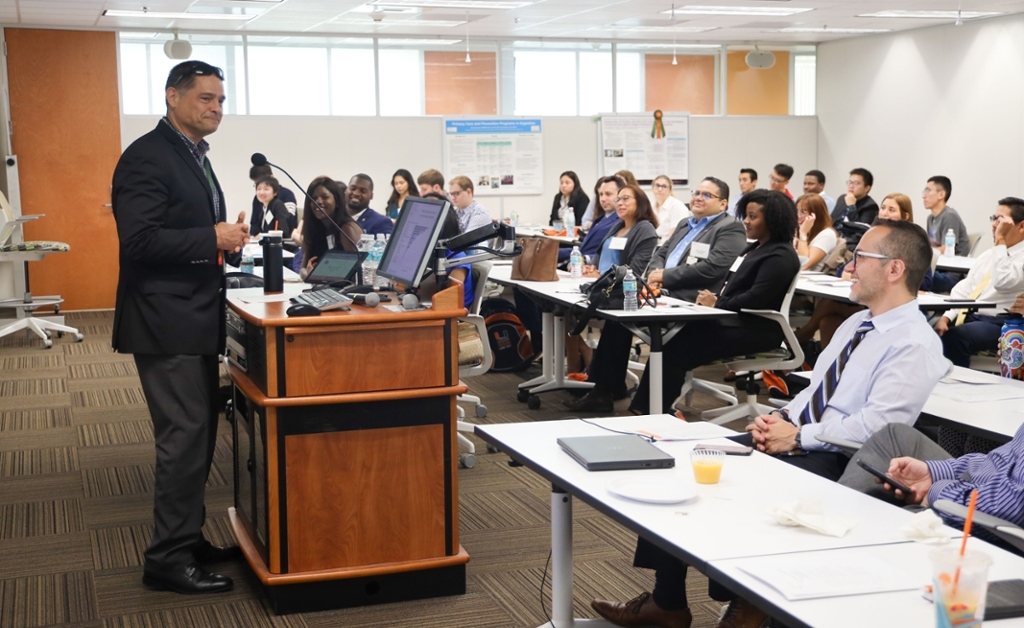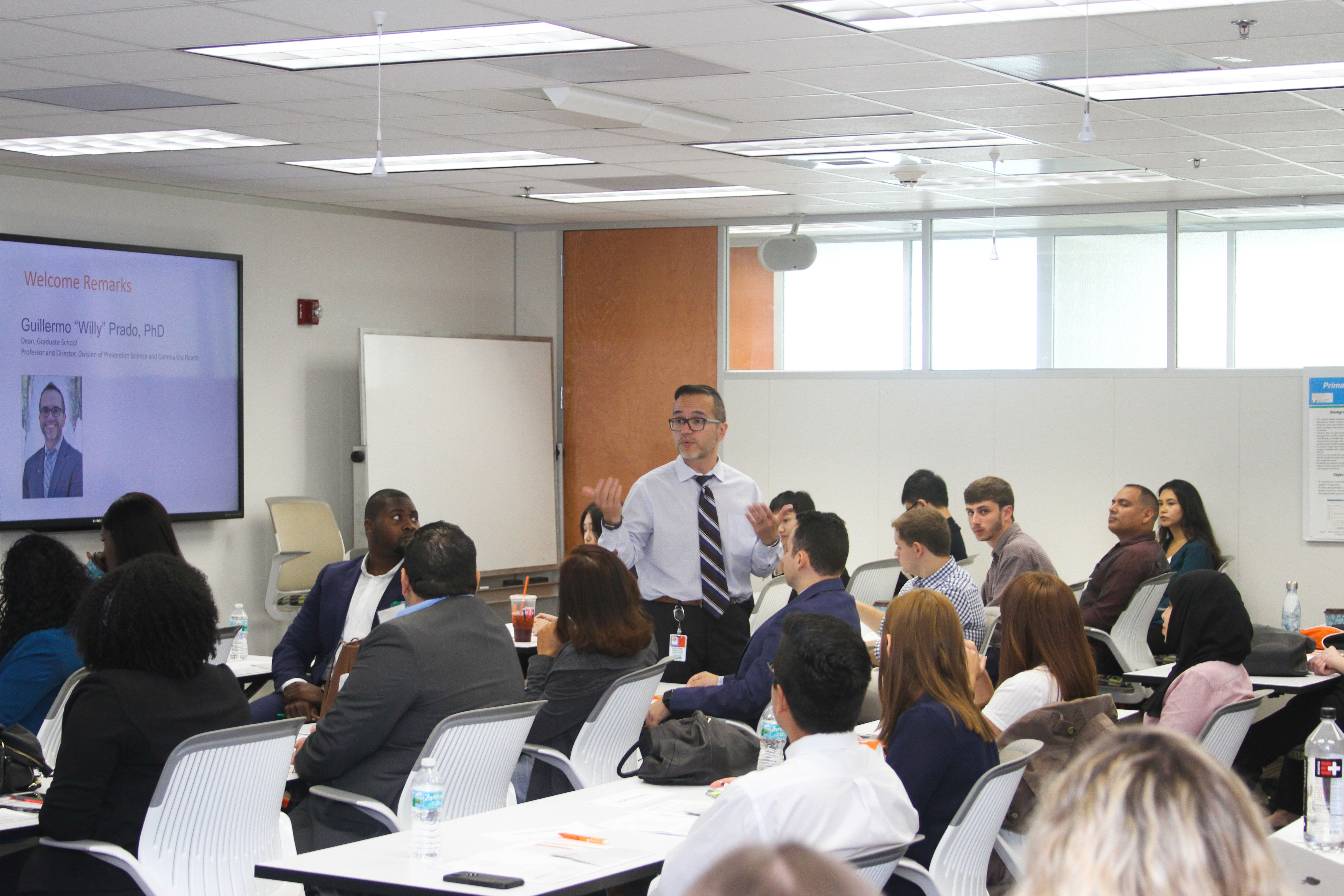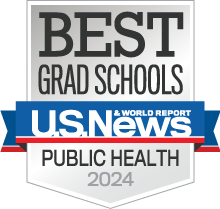Department of Public Health Sciences Welcomes New Graduate Students

On August 15, 2019, the University of Miami Miller School of Medicine’s Department of Public Health Sciences hosted the Fall 2019 orientation at the Don Soffer Clinical Research Center. New graduate students met their fellow classmates, faculty and staff, learned about the various opportunities available to them within the department and at the Miller School, and gathered for coffee and desserts at La Estancia Argentina. This week, they will begin masters, doctoral, and joint degree programs in public health, biostatistics, epidemiology, prevention science and community health, as well as in public administration and Latin American studies.
“I just graduated with my Master in Public Health degree at the department and I will now be starting the Ph.D. in Epidemiology program, particularly focusing on chronic disease and pediatric obesity. A few years ago, I moved from Boston to start my journey in Miami and it was a great decision. I like the culture, faculty, staff and students here. I also don’t miss the cold up north. I’m just overall excited to continue mastering my skills at the Miller School,” said Robert A. Mesa, MPH, a Ph.D. in Epidemiology candidate.
After faculty, staff and Sebastian the Ibis welcomed new students, the orientation officially began with welcoming remarks from Guillermo “Willy” Prado, Ph.D., dean of the University of Miami Graduate School and professor of public health at the Miller School of Medicine. Dr. Prado enthusiastically spoke to them on what the graduate school has to offer, as well as the perks of the graduate student association. He also emphasized the importance of collaboration.
 “As you continue to engage in your coursework, assistantships, and volunteer activities, you will find all of these opportunities to do great public health work, whether it's out in the community, whether it's in a lab, or wherever it may be,” said Dr. Prado, who is also the director of the Division of Prevention Science and Community Health in the department. “I also encourage you to seek other collaborative opportunities within and outside the university. Public health is a highly interdisciplinary field.”
“As you continue to engage in your coursework, assistantships, and volunteer activities, you will find all of these opportunities to do great public health work, whether it's out in the community, whether it's in a lab, or wherever it may be,” said Dr. Prado, who is also the director of the Division of Prevention Science and Community Health in the department. “I also encourage you to seek other collaborative opportunities within and outside the university. Public health is a highly interdisciplinary field.”
Faculty in the Department of Public Health Sciences currently collaborate with other schools within the University, like the School of Architecture, the Miami Business School, and the School of Nursing and Health Studies.
From the Miller School’s Department of Public Health Sciences, David Lee, Ph.D., professor and director of graduate programs, Viviana Horigian, M.D., M.H.A., associate professor and director of public health education, as well as various other program directors also gave opening remarks.
“Our overall goal here is to build transformational leaders. And these transformational leaders are indeed characterized by the ability to collaborate across disciplines. The ability to apply leadership, organizational and problem-solving skills and be an effective advocate for many of the issues that we face,” added Dr. Lee. “Our expectation is that our transformational leaders are going to have a deep understanding of public health and that they maintain a curiosity throughout their lives.”
While Dr. Horigian could not make it to the orientation, students were able to watch an introductory video of her congratulatory remarks to the new cohorts. She spoke about her research and on the importance of being involved outside of the classroom.
“I'm a true believer that the learning experience does not only occur in the classroom. We have a multitude of opportunities for you to engage in learning experiences that go beyond the classroom,” she explained to students in the video. “Those take different shapes and forms. For example, we have a student-led panel on public health critical topics of today, like gun-violence prevention and immigration. We have opportunities for you to go to conferences and opportunities for you to engage in research on current issues that our faculty are addressing.”
The directors of the various master and doctoral programs also introduced themselves to students, including Tulay Koru-Sengul, Ph.D., the director of the Master of Science (M.S.) in Biostatistics program, who also spoke on the Ph.D. in Biostatistics program, and Eric Brown, Ph.D., the director of the M.S. in Prevention Science and Community Health program. WayWay M. Hlaing, Ph.D., the director of the Ph.D. in Epidemiology, also welcomed students, as well as Seth Schwartz, Ph.D., the director of the Ph.D. in Prevention Science and Community Health.
Dr. Schwartz said that the five first-year Ph.D. in Prevention Science and Community Health candidates in the program this year are alumni of the Miller School’s MPH and MSPH programs.
Andria Williams, M.B.A., director of admissions for the Miller School’s Department of Public Health Sciences, presented the statistics that make up the class.
Including all the programs, 54 percent of new students have bachelor degrees, 24 have master degrees and 22 have doctoral degrees. Around 27 percent are also first-generation college students. Their educational backgrounds range from degrees in health science, public health, psychology, to biochemistry, epidemiology, and medicine, each obtained at 40 different national and international universities. It was also found that they have worked 151,387 hours, conducted 22,077 hours of research, and have contributed 33,003 hours to community enrichment.
Culturally, 17 percent of new students are Asian and Asian Indian, 15 percent are Black or African American, 24 percent are Hispanic, 58 are White, and 10 percent were other. There are 56 percent who are Florida residents, 17 percent who are out-of-state, and 27 percent who are international. The average age is 27, 32 percent of the class is male, and 68 percent is female.
“I went to Samford University in Birmingham, Alabama and played football. I’m excited now to be in school and not play a sport at the same time. I’ve always had a ton of affinity toward public health, so I’ll be starting the Master of Public Health and Master of Public Administration joint degree. The program here pairs epidemiology with the clinical and administrative side, which I think makes for a better foundation for a leader of a hospital system, which is eventually where I want to land towards,” said Armando Bonheur, an M.P.H./M.P.A candidate.
The morning session concluded with graduate program staff introductions, which was led by Begoña Rovira, M.B.A., M.A., the executive director of the Master Programs in Public Health. Addys Bertina Karunaratne, Ph.D., a psychologist at Student Affairs, also presented on the opportunities available at the Counseling Center, and James M. Shultz, Ph.D., voluntary associate professor in the Miller School’s Department of Public Health Sciences, spoke about safety information and on hurricane preparedness.
The orientation continued with a lunch program and during this session, students participated in an ice breaker and various student organizations also gave presentations, including the Delta Omega Honorary Society, the Graduate Student Association, and the Public Health Student Association. After a break, Ph.D. students had mandatory advising sessions with their respective program directors. Other graduate students attended break-out sessions with faculty.
After a long, but eventful day, students finished their day by attending a networking social at La Estancia Argentina, a restaurant at walking distance from the Don Soffer Clinical Research Center.
Written by Amanda Torres
Published on August 20, 2019




 “As you continue to engage in your coursework, assistantships, and volunteer activities, you will find all of these opportunities to do great public health work, whether it's out in the community, whether it's in a lab, or wherever it may be,” said Dr. Prado, who is also the director of the Division of Prevention Science and Community Health in the department. “I also encourage you to seek other collaborative opportunities within and outside the university. Public health is a highly interdisciplinary field.”
“As you continue to engage in your coursework, assistantships, and volunteer activities, you will find all of these opportunities to do great public health work, whether it's out in the community, whether it's in a lab, or wherever it may be,” said Dr. Prado, who is also the director of the Division of Prevention Science and Community Health in the department. “I also encourage you to seek other collaborative opportunities within and outside the university. Public health is a highly interdisciplinary field.”
